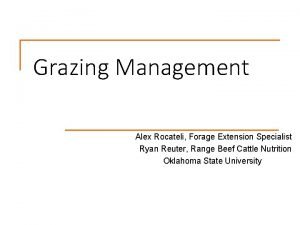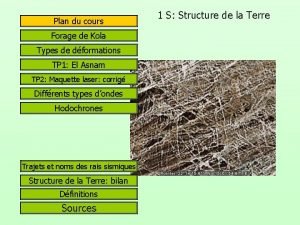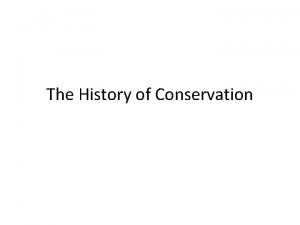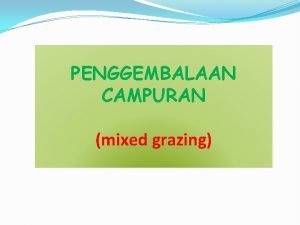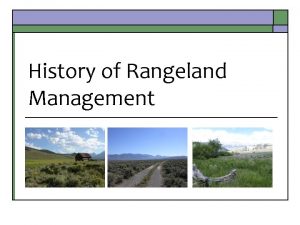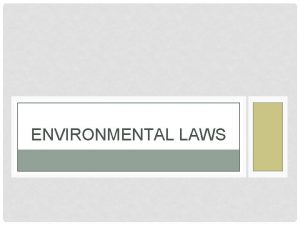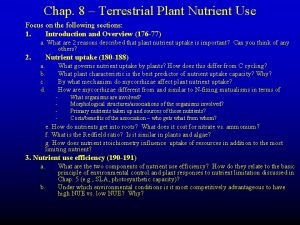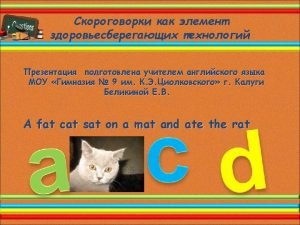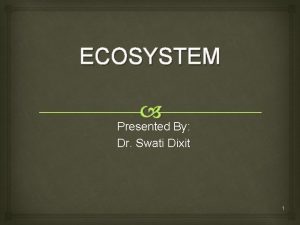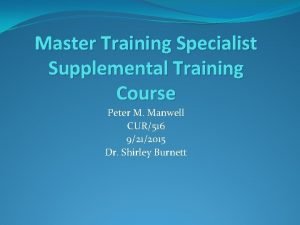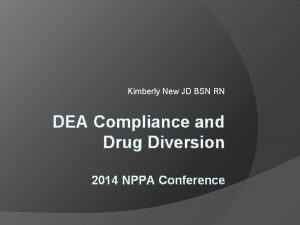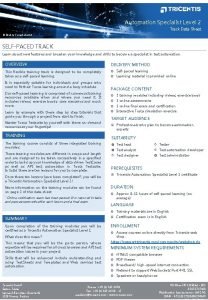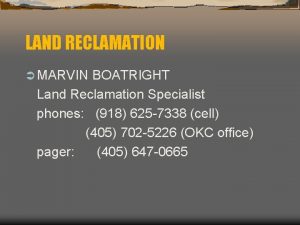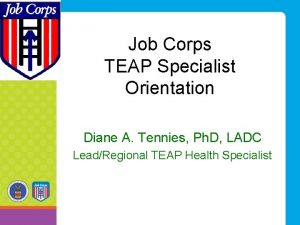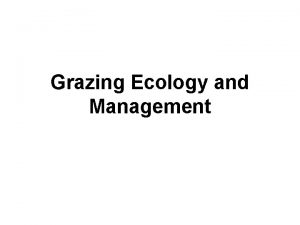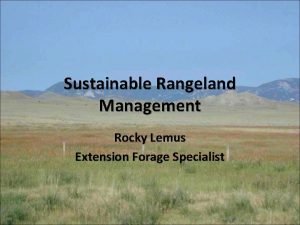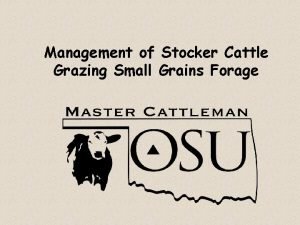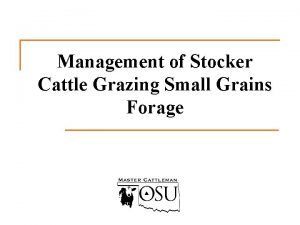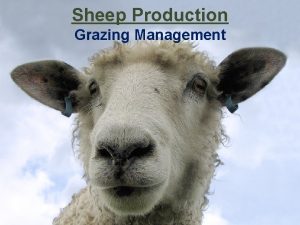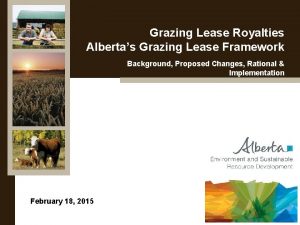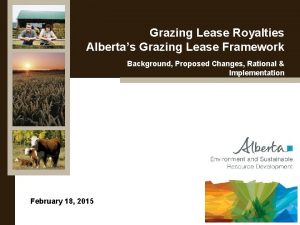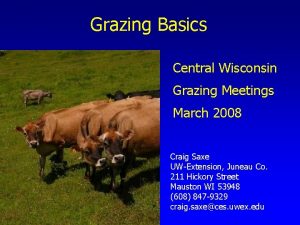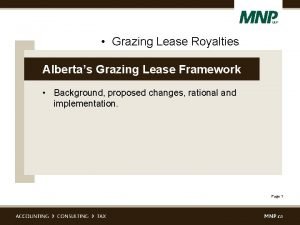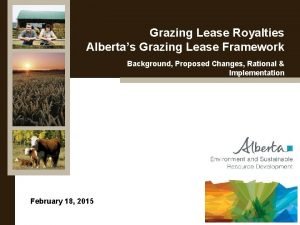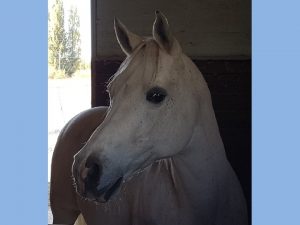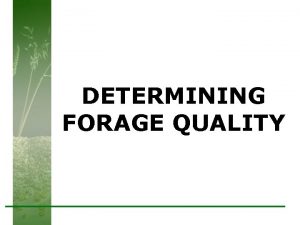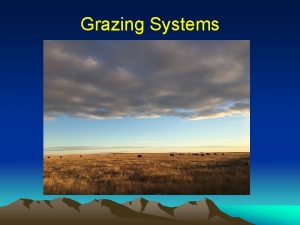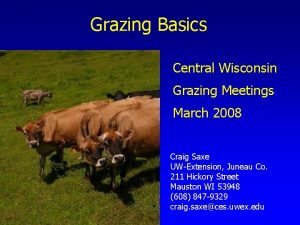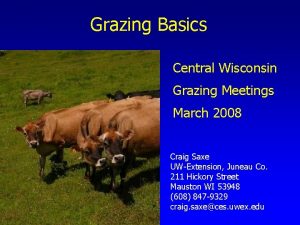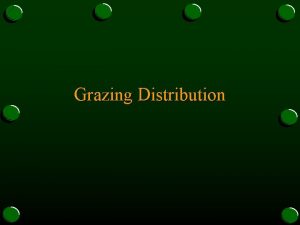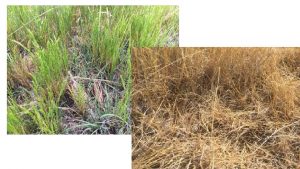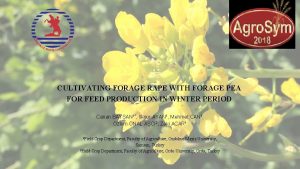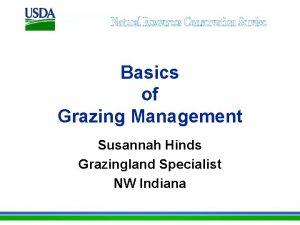Grazing Management Alex Rocateli Forage Extension Specialist Ryan











































- Slides: 43

Grazing Management Alex Rocateli, Forage Extension Specialist Ryan Reuter, Range Beef Cattle Nutrition Oklahoma State University

Objectives n Understand key concepts that affect grazing management n Become familiar with: • adaptation • use • best management practices forages in OK. n Describe grazing managements systems and their effects on: • livestock, • plants, • environment.

Introduction • 2012 Grassland (Acres) n Large part of OK land is dedicated to beef cattle production. n Grazinglands are vital for the state: q natural resources q economic resources q benefits to landowner and society Ø According to the USDA census the total Oklahoma grassland acreage was 22 million acres in 2012 (9 th in US). More recent data showed a total of 4. 3 million cattle incl. calves in 2014 (5 th in US). n Grazing management affects all OK citizens.

Introduction Economy, Logistic & Society Soil Physics, Chemistry & Biology Livestock Forage & Weed Biology Grazing Management Grazing management goal The long-term balance among: § Forage production § Profitability § Ecosystem health § Simplicity § Personal satisfaction

Key concepts 1. Grazing enterprises are very complex systems: Ø Consider all aspects and ramifications of decisions Ø Management can have unintended consequences Ø Management can cause good short-term results and bad long-term results or vice-versa.

Key concepts 1. Grazing enterprises are very complex systems: Decision: Overstocking Outcomes: 1 st year More animal gain More profit Short-term 2 nd, 3 rd, 4 th years Less plant recovery vs. Long-term Less soil cover, more erosion Soil compaction Less forage production Less animal gain Unintended consequences Less profit

Key concepts 2. Forage yield varies Ø There is a seasonal variation in forage yield along trough the year Forage demanded by livestock Storage Forages Surplus Deficit

Key concepts 3. Trade-off: yield vs. quality Ø There is a trade-off between quality and quantity of forage produced. Mature forages will have higher yields and lower quality (High lignin content and, low soluble carbohydrates). The opposite is true!

Key concepts 4. Stocking rate (the number of animals on a land area over time) Overstocking Proper stocking rate

Stocking rate n Keep the correct stocking rate! q Overstocking q Understocking q Forage matures quickly q Big concern! q Long-term negative effects: q Low quality forage q Less forage q More weeds q Less soil water

Stocking rate n Implementing correct stock rate is a challenge! q Forage supply varies year to year due to weather and management conditions n Grazing stick: a way to estimate forage supply q Inputs n n n Canopy height Canopy cover Paddock size Type of forage Type of animal Grazing days

Key concepts 5. Grazinland Types: n Native pastures/Rangelands q Ecological processes q Management: n Prescribed Fire n Grazing Ø Stocking rate n Introduced pastures q Technological Processes q Management: n Fertilization n Herbicide n Grazing Ø Fencing Ø Stocking rate

Grazinland types n Native Pastures Tallgrass prairie Ozarks Shortgrass/plains prairie Midgrass praire Cross Timbers Quachita Mountains, Arkansas River Valley, and Western Gulf Costal Plain region

Grazinland types n Native Pastures q Shortgrass prairie Blue Grama Hairy Grama Buffalograss Sideoats Grama

Grazinland types n Native pasture q Midgrass prairie Silver Bluestem Little Bluestem Vine Mesquite Sideaots Grama

Grazinland types n Native pasture q Tallgrass prairie Big Bluestem Switchgrass Indian Grass Little bluestem

Grazinland types n Native Pasture q Cross Timbers Midgrass prairie Oaks Tallgrass prairie Cedar Ø There is no distinct boundary between Cross Timbers and adjacent prairies, therefore grasses from both tallgrass and midgrass prairie are embedded within the Cross Timbers woodlands.

Grazinland types n Introduced pastures

Grazinland types n Introduced pastures q Main factors affecting the types distribution in OK: Normal Annual precipitation Length of growing season

Grazinland types n Introduced pastures – Actual Production Ø Alfalfa Ø Cowpea Ø Mungbean Ø Ø Ø Ø Ø Native grasslands Bermudagrass Sudangrass Pearl millet Forage sorghums Wheat Cereal rye Oat Barley Ø Crabgrass Ø Fox Millet Ø Switchgrass Ø Old World bluestems Ø Bahiagrass Ø Dallisgrass Ø Annual bromegrasses Ø Tall/int. wheatgrass Ø Weeping lovegrass Ø Eastern gamagrass Ø Austrian winterpea Ø Annual ryegrass Ø Soybean forage Ø Orchardgrass Ø Soybean forage Ø Pasture legumes Ø Tall fescue ü Source: Oklahoma Forage and Pasture Fertility Guide, Pa. SS, OSU Ø Smooth bromegrass

Complementary forage systems n No single forage produces high-quality, abundant forage year round in Oklahoma

Complementary forage systems n Two main strategies: 1. Complementary forages in same field ü Cattle in the field all year round Example: Bermudagrass pasture overseed with annual rye + clover Ø Late spring – late summer: bermudagrass Ø Early fall – mid spring: rye and clover

Complementary forage systems n Two main strategies: 1. Complementary forages in separated fields Bermudagrass 80 acres Native Pasture 320 acres most summer kept here when other pastures are recovering. Wheat most fall & winter 40 acres

Grazing methods n “the way that livestock are managed and allowed access to the grazinland” n Two types: Continuous grazing Rotational grazing

Grazing methods q. Continuous grazing - Livestock in the same pasture all season Ø Temporary fence avoids grazing during surplus forage growing season. The isolated area will be harvested for hay or silage. The stored forage will feed the livestock during low forage growth season.

Grazing Methods q. Rotational grazing - Livestock will graze different pasture portions in different timing. Ø Field is divided in paddocks. Livestock will move every 3 – 10 days based on remaining forage height. The forage in a grazed paddock will properly regrow. Ø Temporary fences move every day changing the livestock position. Strips are smaller than paddocks.

Grazing Methods Continuous Rotational n Benefits q Lower labor use q Even forage use q Minimal fencing q Improved long-term forage yield q Minimal water development q Improved forage quality (maturity control) q Potential increase in n Disadvantages stocking rate q Uneven forage use n Disadvantages q Potential decrease in stocking rate q Higher labor use q More fencing q More water development

Grazing Methods effects forage Utilization: Grazing Method Low Efficiency High Efficiency Continuous Stocking 30% 50% Slow Rotation (2 -4 paddocks) 50% 60% Moderate Rotation (4 -6 paddocks) 60% 70% Strip Grazing, MOB, Daily, etc. 70% 80% Hay Harvest 30% 75%

Fencing – Rotational Systems n Boundary fences n Built strong for containing animals inside ranch perimeter n Interior fencing n Create paddocks (“sub-pastures”) for rotation n Built lighter and less expensive than boundary fences n Types: q Physical fences: traditional net wire or barbed fences q Psychological fences: electric fences q Temporary fences: polywire (animal trained to honor electric fences)

How much fencing? n depends on how many paddocks n there is a diminishing return in pasture rest period to building additional paddocks (requires more fencing) n it is recommended 4 -6 paddocks as a good way to start rotational grazing: Increases: 14 rest days 7 rest days 3 rest days

Grazing management plan - Example 1. Survey of land resources - Location: Stillwater, OK Prairie: Crosstimbers Total Acreage: 374 acres Potential Water Sources source: Google Earth Pro

Grazing management plan - Example 1. Survey of land resources – Climate/Weather Soil depth: 40 inches Water storage capacity low: 5 -6 inches 2015 can considered: § “favorable” year for warm-season grasses § “unfavorable” for late cool-season grasses Low soil water late in Aug • Most of warm-season grasses were mature, therefore low impact in growth. source: Oklahoma Mesonet

Grazing management plan - Example 2. Determine grazeable acreage Total Acreage: 374 acres Trees+roads+buildinds: 40 acres Pastureland (90%): 334 acres source: Google Earth Pro

Grazing management plan - Example 3. Determine soil type – Texture and depth Soil depth: 20 -40 inches Low Water storage capacity low: 5 -6 inches Fertilization issue: leaching – split application source: Soil Survey

Grazing management plan - Example 4. Determine existing forages – Amount “Favorable year” – good rainfall Total Grass production = 3459 lbs/acre/yr Grazeable area (90%) = 3100 lbs/acre/yr source: Soil Survey

Grazing management plan - Example 4. Determine existing forages – Amount source: Soil Survey n Grazing stick: a way to estimate forage supply q Inputs n n n Canopy height Canopy cover Paddock size Type of forage Type of animal Grazing days Ø The soil survey estimation is very crude. Therefore, estimating forage availability in the pastureland will be more accurate.

Grazing management plan - Example 4. Determine existing forages – Seasonal source: Soil Survey § Estimating Species composition (visual): § Warm and cool-season forages § Noxious plants § Weeds

Grazing management plan - Example 5. Estimating herd size – Based on forage availability source: Soil Survey Ø Biomass production = 3. 5 ton/acre/year Ø Favorable year Ø Grazeable forage = 3. 5 – 1 = 2. 5 tons/acre/year Ø No grazing lower than 3 inches height Ø 0. 3 ton/inch/acre X 3 inches = 1 ton/acre Ø Total grazeable forage = 2. 5 tons/acre/year X 334 acres = 835 tons/year

Grazing management plan - Example 5. Estimating herd size – Based on forage availability source: Soil Survey Ø Total utilized forage = 835 x 0. 5 = 417 tons/year Ø Continuous stock (low forage utilization rate) = 50% Ø 1 animal-unit consumes 26 lbs forage/day, or 9. 5 tons/year Ø 1 animal-unit (AU) = 1, 000 lbs mature cow Ø 1 AU consumes in average 2. 6% of its weight per day

Grazing management plan - Example 5. Estimating herd size – Based on forage availability source: Soil Survey Ø Number of cows = 417/9. 5 = 43. 89 AU Ø Continuous Ø Low input Ø No fencing Ø No fertilization Ø 8. 7 acres / cow

Grazing management plan - Example 6. How to increase the herd size? ü Changing your grazing method Grazing Method source: Soil Survey Low Efficiency High Efficiency Continuous Stocking 30% 40% Slow Rotation (2 -4 paddocks) 50% 60% Moderate Rotation (4 -6 paddocks) 60% 70% Strip Grazing, MOB, Daily, etc. 70% 80% Hay Harvest 30% 75%

Grazing management plan - Example 6. How to increase the herd size? source: Soil Survey ü Converting portion of your field to introduced grasses – complementary forages. ü Proper fertilization ü Weed control

Questions?
 Costal plain
Costal plain Forage de kola
Forage de kola Flanker brand strategy
Flanker brand strategy Taylor grazing act 1934
Taylor grazing act 1934 Taylor grazing act 1934
Taylor grazing act 1934 Sistem grazing continuous
Sistem grazing continuous Taylor grazing act 1934
Taylor grazing act 1934 Food chain food chain food chain
Food chain food chain food chain Taylor grazing act 1934
Taylor grazing act 1934 Protect bougainvillea from grazing animals.
Protect bougainvillea from grazing animals. Navajo nation grazing permit laws
Navajo nation grazing permit laws Grazing food chain
Grazing food chain Three gray geese in the green grass grazing
Three gray geese in the green grass grazing Structure of ecosystem
Structure of ecosystem Crow food chain
Crow food chain Pain management specialist
Pain management specialist Non specialist audience
Non specialist audience Formula sheet specialist
Formula sheet specialist Seo punto rojo
Seo punto rojo Prm specialist
Prm specialist Web accessibility specialist certification
Web accessibility specialist certification Do microsoft office specialist certifications expire
Do microsoft office specialist certifications expire Master training specialist
Master training specialist Dea compliance specialist
Dea compliance specialist Coating application specialist
Coating application specialist Specialist species
Specialist species Specialist species
Specialist species Arithmetic mean diameter formula
Arithmetic mean diameter formula Specialist creed
Specialist creed Offender workforce development specialist
Offender workforce development specialist Maritime specialist
Maritime specialist Specialist species
Specialist species Tricentis automation specialist level 1
Tricentis automation specialist level 1 Unit 4 common specialist technical principles
Unit 4 common specialist technical principles Specialist maths school
Specialist maths school Specialist software examples
Specialist software examples Boeck candy test
Boeck candy test Tobacco treatment specialist training
Tobacco treatment specialist training Ibms certificate of competence
Ibms certificate of competence Marvin boatright
Marvin boatright Teap specialist
Teap specialist Specialist skills sociology
Specialist skills sociology Muslim specialist hospital zaria
Muslim specialist hospital zaria Academyofpeerservices
Academyofpeerservices
